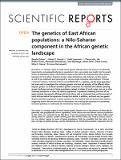Por favor, use este identificador para citar o enlazar a este item:
http://hdl.handle.net/10261/153231COMPARTIR / EXPORTAR:
 SHARE SHARE
 CORE
BASE CORE
BASE
|
|
| Visualizar otros formatos: MARC | Dublin Core | RDF | ORE | MODS | METS | DIDL | DATACITE | |

| Título: | The genetics of East African populations: a Nilo-Saharan component in the African genetic landscape |
Autor: | Dobon, Begoña CSIC ORCID; Hassan, Hissam Y.; Laayouni, Hafid CSIC ORCID; Luisi, Pierre CSIC ORCID; Ricaño- Ponce, Isis; Zhernakova, Alexandra; Wijmenga, Cisca; Tahir, Hanan; Comas, David CSIC ORCID ; Netea, Mihai G.; Bertranpetit, Jaume CSIC ORCID | Fecha de publicación: | 28-may-2015 | Editor: | Nature Publishing Group | Citación: | Scientific Reports 5: 9996 (2015) | Resumen: | East Africa is a strategic region to study human genetic diversity due to the presence of ethnically, linguistically, and geographically diverse populations. Here, we provide new insight into the genetic history of populations living in the Sudanese region of East Africa by analysing nine ethnic groups belonging to three African linguistic families: Niger-Kordofanian, Nilo-Saharan and Afro-Asiatic. A total of 500 individuals were genotyped for 200,000 single-nucleotide polymorphisms. Principal component analysis, clustering analysis using ADMIXTURE, FST statistics, and the three-population test were used to investigate the underlying genetic structure and ancestry of the different ethno-linguistic groups. Our analyses revealed a genetic component for Sudanese Nilo-Saharan speaking groups (Darfurians and part of Nuba populations) related to Nilotes of South Sudan, but not to other Sudanese populations or other sub-Saharan populations. Populations inhabiting the North of the region showed close genetic affinities with North Africa, with a component that could be remnant of North Africans before the migrations of Arabs from Arabia. In addition, we found very low genetic distances between populations in genes important for anti-malarial and anti-bacterial host defence, suggesting similar selective pressures on these genes and stressing the importance of considering functional pathways to understand the evolutionary history of populations. | Versión del editor: | http://doi.org/10.1038/srep09996 | URI: | http://hdl.handle.net/10261/153231 | DOI: | 10.1038/srep09996 | ISSN: | 2045-2322 |
| Aparece en las colecciones: | (IBE) Artículos |
Ficheros en este ítem:
| Fichero | Descripción | Tamaño | Formato | |
|---|---|---|---|---|
| srep09996.pdf | 826,36 kB | Adobe PDF |  Visualizar/Abrir |
CORE Recommender
PubMed Central
Citations
14
checked on 06-may-2024
SCOPUSTM
Citations
24
checked on 03-may-2024
WEB OF SCIENCETM
Citations
24
checked on 25-feb-2024
Page view(s)
365
checked on 09-may-2024
Download(s)
579
checked on 09-may-2024

